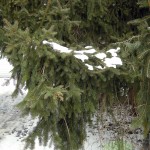 Yikes, It’s spring, and my lawn looks a scary combo of yellow and brown spots all over- what happened??
Yikes, It’s spring, and my lawn looks a scary combo of yellow and brown spots all over- what happened??
So what should I expect to happen to my lawn after winter? What happens when your lawn doesn’t get enough snow, too much snow? What happens when ice covers my lawn??
All of these situations have varying effects on lawns, but the one common things is that they are incredibly stressful on turfgrass. Some winters are worse than others, and sometimes it seems like your efforts from last year have gone to waste. But lawns are resilient, the damage is mostly superficial, and a LawnSavers lawn will bounce back better than ever as the compound effect of our programs build more resilience into your soil and grass roots.
Why snow is good for your lawn
A thick layer of snow acts like a blanket – sheltering and insulating your lawn through the winter. It prevents the ground from drying out and stops ice from damaging the grass crown and roots.
When the weatherman says we’ll be getting a real winter of cold weather and lots of snow this winter, this is good news for your lawn!
Plus, when the snow melts and April showers arrive, this will give your plants a lot more water to grow with when things warm up. Your LawnSavers specially formulated Ultra-Slow-Release Polyon Fertilizer will ensure that your lawn greens up as the soil temperatures slowly rise.
Soil and Air Temperatures play an important role!
Understanding how lawns and trees wake up in the spring is to understand the effects temperatures have on plant growth. Warm late-March and April days seem great, but the soil is likely still frozen from the winter. These air temperatures can be a problem when the roots get a signal from above to grow, but then can’t seem to access any water or nutrients because there roots are frozen in the soil.
Every spring people are anxious to grow new grass seed but dont realize that the soil temperature governs when grass will germinate. A good rule of thumb is that the soil temperature needs to be 15 deg C at a depth of 2-3″ under the soil to make better grass seed varieties germinate properly. (this is why seeding in fall is ideal- you have cooler air combined with warm soil)
Some conditions to watch out for:
- On the downside, a steady, thick blanket of snow may encourage voles to create their ‘runways’, but that’s minor damage a healthy lawn can easily recover from.
- On the other hand, Ice that covers a lawn can create a lot of damage by preventing air transfer from the soil and turfgrass blades- and the damage can be done in only a few days. So ice storms are not a good thing!
- Debris like leftover leaves you didn’t rake, or fallen twigs will encourage mould when trapped under the snow cover. So if you were not able to rake or mulch all the leaves on your lawn before the big snows hit, be ready to deal with some damage in the spring.
- When spring arrives, a burst of warmth that triggers growth can also cause issues when followed by freezing temperatures. It confuses plants and causes them to return to dormancy (which looks like more brown or yellow spots).
- Another thing people often notice in the spring, is that it normally reveals your dogs favorite spot to do their ‘business’ all winter. As the grass begins to green, the salts from the dogs urine burn the roots, while other parts green up nicely in a halo around the grass. (more here)
What about trees and snow?
The weight of accumulated snow can damage upwards-growing evergreens, bending the boughs down to the ground. Where possible you should have these shrubs wrapped tightly in protective burlap. A gentle shake or brushing will remove what snow has already built up.
Learn about spring recovery with our Ontario Lawn Care Schedule!












